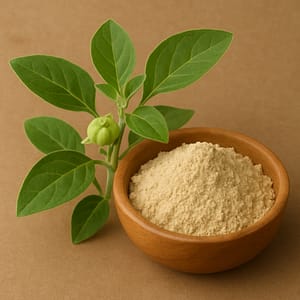- Home
- Ashwagandha

I. General Information
A. Scientific Name:
Withania somnifera
B. Alternative Names:
Indian Ginseng, Winter Cherry, Asgandh (Hindi), Amukkara (Tamil)
C. Pronunciation:
Ash-wa-gan-dha
II. Sourcing and Origin
A. Source:
Root (primarily), leaves and berries are also used in traditional remedies.
B. Geographic Origin:
Native to India, parts of the Middle East, and North Africa; now cultivated globally in warm, dry regions.
C. Method of Processing:
The roots are harvested after the plant matures (about 150–180 days), washed, dried in shade, and ground into powder or extracted into liquid or capsule form for supplements.
III. Properties and Uses
A. Physical Properties:
Appearance: Fine light brown or beige powder
Taste: Slightly bitter, earthy, and pungent
Aroma: Herbal with subtle woody undertones
Solubility: Partially soluble in water; dissolves well in milk or oil-based preparations
B. Chemical Composition:
Active Compounds: Withanolides, alkaloids (somniferine, anaferine), saponins, and flavonoids
Nutrients: Iron, amino acids, antioxidants
Bioactive Properties: Adaptogenic, anti-inflammatory, antioxidant, and rejuvenating
C. Primary Uses:
Skincare:
Helps reduce inflammation and oxidative stress
May promote collagen production and combat signs of aging
Common in rejuvenating face masks and creams for stressed or tired skin
Haircare:
Strengthens follicles and reduces scalp inflammation
Supports hair growth by improving circulation
Often infused in herbal hair oils or scalp treatments
Wellness:
Renowned adaptogen that supports stress relief and hormone balance
Enhances energy, stamina, and sleep quality
May support thyroid and immune function
Culinary:
Traditionally mixed with warm milk, honey, or ghee as a tonic
Used in herbal teas, smoothies, or functional lattes for calming effects
Household:
Used as part of Ayurvedic herbal blends (e.g., churna powders) for daily wellness
Sometimes added to herbal sachets or incense for grounding aroma
D. Key Benefits:
Reduces stress and anxiety (lowers cortisol levels)
Improves sleep and relaxation
Boosts energy and physical endurance
Enhances cognitive function and memory
Supports hormonal balance and reproductive health
Strengthens immunity and overall resilience
IV. Safety and Considerations
A. Potential Allergies:
Rare, but may cause mild stomach upset or drowsiness in sensitive individuals
Avoid if allergic to plants in the nightshade family (e.g., tomatoes, eggplants)
B. Best Practices for Use:
Powder: Mix ½–1 teaspoon in warm milk, water, or smoothies daily
Capsules/Tincture: Follow dosage indicated on product label
Topical: Combine with honey, aloe vera, or oils for skincare and hair masks
Timing: Often taken at night for relaxation and improved sleep
C. Special Precautions:
Avoid during pregnancy or breastfeeding without medical guidance
May interact with thyroid, sedative, or blood pressure medications
Consult a healthcare provider before prolonged or high-dose use
V. Fun & Educational Facts
A. Historical Context:
Ashwagandha has been used for over 3,000 years in Ayurvedic medicine. Known as a Rasayana herb, meaning “rejuvenator”, it was traditionally prescribed to promote longevity, strength, and vitality. Warriors and yogis took it to improve endurance and calm the mind before meditation.
B. Did You Know?
The name Ashwagandha comes from Sanskrit, “ashva” (horse) and “gandha” (smell), meaning “the smell of a horse,” symbolizing the vigor and strength it imparts.
C. DIY Recipe Idea:
1. Ashwagandha Moon Milk
1 cup warm milk (dairy or plant-based)
½ tsp Ashwagandha powder
¼ tsp cinnamon
A pinch of nutmeg
1 tsp honey (optional)
✨ Drink before bed to promote deep sleep and relaxation.
2. Energy Smoothie
1 banana
1 cup almond milk
½ tsp Ashwagandha powder
1 tbsp cacao powder
A few ice cubes
🥤 Blend for a natural stress-relief smoothie with a mood boost.
